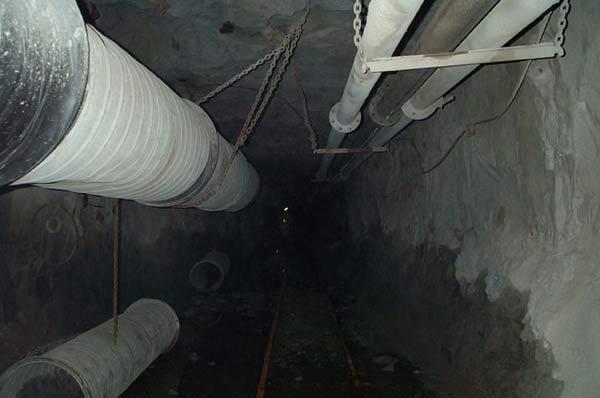
Miles beneath the Earth's surface, where no light or air reaches, tiny organisms are eking out a meager existence.
Yet despite making up an estimated 6 percent of all life on Earth, researchers know almost nothing about these deep-dwellers. And scientists have failed to culture, or grow, the bacteria in the lab, making it difficult to understand how they survive the harsh, energy-starved environment below the planet's surface.
"We're asking really basic, fundamental, big-time questions: Who is there? What are they doing? How did they get there? How many of them are there?" said Jan Amend, an earth scientist at the University of Southern California's Center for Dark Energy Biosphere Investigations. "These are really, really simple questions but very fundamental ones we don't know the answers to."
To answer some of these questions, scientists have embarked on a census to catalog the life buried beneath the Earth's surface. What they find could help them understand the origins of life on Earth, or reveal the kinds of life that could survive on other planets. [7 Theories on the Origin of Life]
Over the last several decades, researchers have probed the microbial communities living on the seafloor, then gradually pushed beneath the surface. Deeper and deeper, scientists still found life. The deepest life yet found are bacteria living 2 miles (3.2 kilometers) below the surface in South African gold mines. (And in 2011, scientists even found worms that live underground and eat those bacteria.)
But bacteria and archaea have been found in sediments in hydrothermal vents, subglacial lakes, mud volcanoes, underwater mountains and many other environments, said Rick Colwell, a microbiologist at Oregon State University, who presented results from a new census of such organisms earlier this month at the American Geophysical Union meeting in San Francisco. Everywhere researchers look, the subsurface is teeming with life.
Diverse communities
Sign up for the Live Science daily newsletter now
Get the world’s most fascinating discoveries delivered straight to your inbox.
To begin to catalog these communities, Sharon Grim of the Marine Biological Laboratory in Woods Hole, Mass., and colleagues such as Colwell, with the Census of Deep Life, have begun analyzing genetic data from all the underground archaea and bacteria they can, including a key identifying set of genes.
"It's like an organism's dog tags, it indicates to a rough extent who they are," Colwell told LiveScience.
Though the results are still early, they are finding that the life at that depth is incredibly diverse, Colwell said.
They have also found one type of archaea in about a third of their samples from all over the world, and in all the archaeal communities sequenced. Like the krill that feed a plethora of other animals in the oceans, it may be a keystone species that needs to be present for such primitive organisms to thrive, Colwell said.
Very similar life forms have also been found in communities in wildly differing environments. So either evolution has forced them to evolve to the subsurface in similar ways, or these organisms share an ancient root close to the origin of life.
Cautious results
But interpreting the results takes caution, Colwell said.
Because there are so few of the deep-dwellers and they reproduce so slowly, any whiff of contamination from quickly-growing, plentiful surface microbes can drown out the faint genetic signal from these bacteria.
The dark-dwellers reproduce only every few months or years and have glacially slow metabolisms, with some organisms moving the equivalent of just a few electrons per second, said Jens Kallmeyer, a geochemist at the University of Potsdam in Germany.
"We cannot understand how an organism can possibly survive on that little energy," Kallmeyer told LiveScience.
Broader implications
The findings have broader implications for life on Earth. For one, deep bacteria, like their aboveground brethren, play a role in the breakdown and cycling of carbon in the environment. That, in turn, affects how much carbon dioxide reaches the atmosphere and alters the climate.
But perhaps the greatest insights these groundlings can tell us is about life on other planets.
These creatures are living at the very edges of hospitable environments — with strange and scarce energy sources, little to no water and scorching heat. Many spend their lives bound to minerals, and move only with the random motion of molecules in the sediments. As a result, they can tell us a lot about the limits of life in the harsh environments of other planets, Amend said. [5 Bold Claims of Alien Life]
Many scientists think life on Earth may have emerged from hydrothermal vents in the seafloor, so these primitive subsurface dwellers could reveal insights into the first primitive cells that started life on Earth, Amend said.
Follow Tia Ghose on Twitter and Google+. Follow OurAmazingPlanet @OAPlanet, Facebook and Google+. Original article on LiveScience's OurAmazingPlanet.

Tia is the managing editor and was previously a senior writer for Live Science. Her work has appeared in Scientific American, Wired.com and other outlets. She holds a master's degree in bioengineering from the University of Washington, a graduate certificate in science writing from UC Santa Cruz and a bachelor's degree in mechanical engineering from the University of Texas at Austin. Tia was part of a team at the Milwaukee Journal Sentinel that published the Empty Cradles series on preterm births, which won multiple awards, including the 2012 Casey Medal for Meritorious Journalism.










